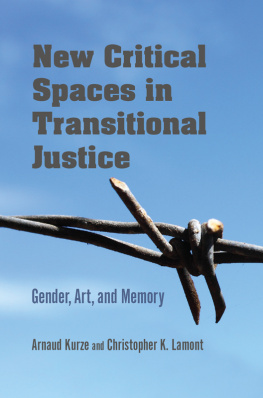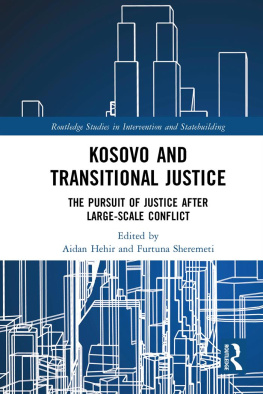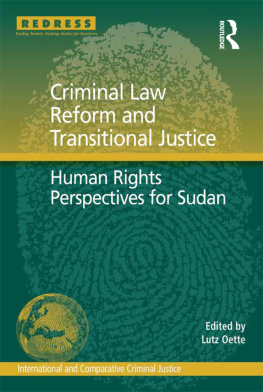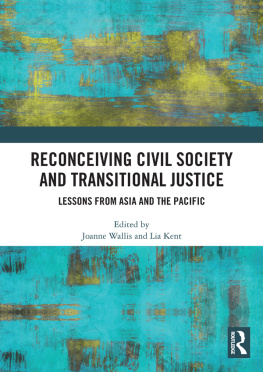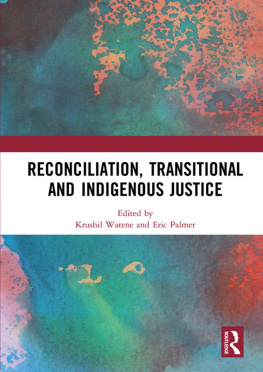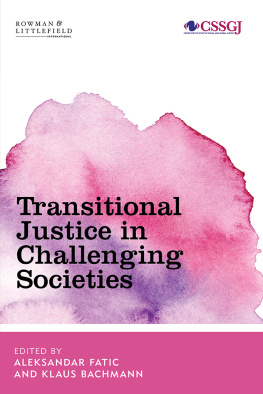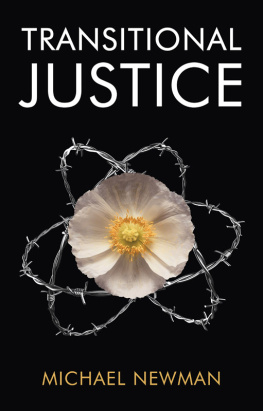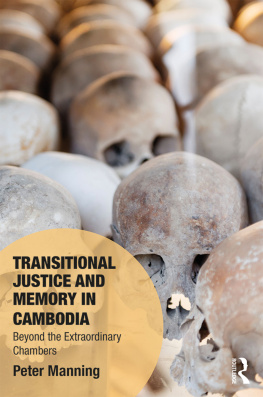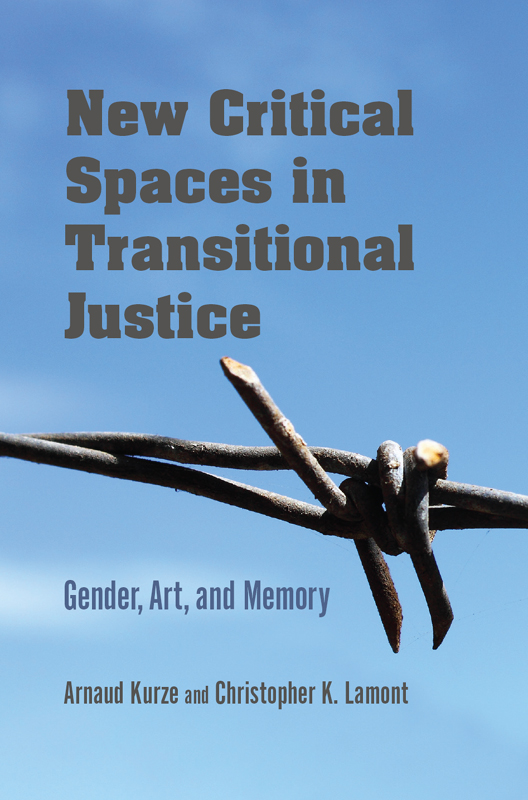Contents
Guide
NEW CRITICAL SPACES IN TRANSITIONAL JUSTICE
This book is a publication of
Indiana University Press
Office of Scholarly Publishing
Herman B Wells Library 350
1320 East 10th Street
Bloomington, Indiana 47405 USA
iupress.indiana.edu
2019 by Indiana University Press
All rights reserved
No part of this book may be reproduced or utilized in any form or by any means, electronic or mechanical, including photocopying and recording, or by any information storage and retrieval system, without permission in writing from the publisher. The paper used in this publication meets the minimum requirements of the American National Standard for Information SciencesPermanence of Paper for Printed Library Materials, ANSI Z39.48-1992.
Manufactured in the United States of America
Cataloging information is available from the Library of Congress.
ISBN 978-0-253-03989-7 (hardback)
ISBN 978-0-253-03990-3 (paperback)
ISBN 978-0-253-03993-4 (ebook)
1 2 3 4 5 24 23 22 21 20 19
CONTENTS
W E LIVE IN A TIME OF POLITICAL INSTABILITIESGIVEN the blurring of the public and private spheres in the area of security, in light of the context of rapid globalization, new technologies, as well as the expansion of new communications, social media, and populist politics. All of these have consequences for the prospects of how societies should deal with conflict and violence and, moreover, how to achieve accountability for social, economic, and political injustice.
The question has become even more acute given that in this volatile context, belief in rule of law seems to have reached a new low, especially by way of contrast with the midcentury watershed achievements in international lawexpressed in populist politics and overall distrust of liberal democracies, politics, and state institutions. It is in this new context that one can see the significance of this edited volume offering an alternative study of promoting alternative means of transitional justice.
Moving beyond the by now well-documented state-driven attempts to promote transitional justice after the fall of autocratic regimes and the end of violent conflict, the books editors, Arnaud and Christopher, both experts in the field, whose work I have seen over the years, have brought together important contributions to explore the tensions between state-society relations in the twenty-first century, providing an intellectual space to discuss civil society actors and forms of addressing accountability, remembrance, and forgiveness. Both editors do an excellent job in gathering an outstanding caliber of young creative scholars and practitioners in the field to shed light on lesser known diverse transitional justice actors practices and related values around the world.
When it comes to rule of law and accountability, what does it mean to be beyond the transition and beyond the state? This volume reckons with the role of nonstate actors and their goals and values. Addressing the issue of sidelined and often-ignored stakeholders, such as youth in the post-Arab Spring world, some of the authors aim to capture the importance of power struggles of marginalized actors to create a voice and recognition as victims. Grassroots movements, mobilizing for collective action to spread ideas and advocate for victims rights, are an essential part of this struggle. In addition, however, art has played a crucial role in fueling new forms of postconflict and postauthoritarian justice in various contexts. Performance activism, street art, and cyber activism are among the new tool kit of transitional justice practices. Moreover, several contributors grapple with gender-related issues, ranging from empowering womens rights to male victims of sexual violence. The latter still represents a major taboo that has finally appeared on the agenda of policy makers and practitioners but which, this book reminds, still faces the early stigma of when sexual violence was first raised at war crimes trials at the International Criminal Tribunal for the former Yugoslavia. Here, we find a wide range of imaginaries of what justice in transition can mean in these times of seemingly ongoing political flux. Hence, the volume contributes substantially and timely to pressing debates in transitional justice that are not only important to scholars and experts in the field but also of valuable interests to lawmakers, practitioners, and students of human rights, democracy, and global justice at large.
Ruti Teitel
Ernst C. Stiefel Professor of Comparative Law
at New York Law School
Manhattan, New York 2018
T HIS EDITED VOLUME COULD NOT HAVE BEEN PUBLISHED without the help and inspiration of many individuals and organizations. We are particularly grateful to our Indiana University Press editors, Jennika Baines and Kate Schramm, for their diligent help and enthusiastic support throughout the process, as well as our anonymous reviewers for their constructive feedback to improve the manuscript. While we are unable to list everyone here, we would nonetheless like to provide our readers with a brief genealogy, mapping the early stages of the project to give a sense of the intellectual journey, the challenges, and achievements, culminating in the final product.
The Woodrow Wilson Center for International Scholars in Washington, DC, represents one of the early pillars of support. In particular, the director of the Global Europe Program, Christian Ostermann, provided research opportunities for Arnaud Kurze, who benefitted from a Global Fellowship and used the center as a scholarly testing ground for some of the initial ideas on new actors and forms of transitional justice, including youth advocacy and performance activism. The center and its staff continue to support ideas and work that have resulted from the project.
The key momentum for the idea of an edited volume emerged after a panel discussion during the 2015 annual conference of the International Studies Association in New Orleans, when issues of civil society, art, and postArab Spring transitional justice were discussed among the participants. Follow-up conferences, such as the International Humanitarian Studies Association annual conference in Addis Ababa in spring 2016, helped expand the empirical and theoretical grounds for the book. Each of these professional events helped bring together this volumes contributors to build the foundation for a comprehensive and compelling piece of work.
Last but not least, the annual Cres Summer School on Transitional Justice in Croatia provided an excellent space for the editors and some of our contributors to consolidate and further elaborate on key concepts. In addition to the scholars and practitioners, participating students represented a critical and receptive audience to further examine many of the issues addressed in the book. We are extremely grateful for all the comments and remarks from our colleagues, students, friends, and family who helped to shape the final results of this work.
NEW CRITICAL SPACES IN TRANSITIONAL JUSTICE
T HE PAST IS NEVER DEAD. ITS NOT EVEN PAST, William Faulkner wrote in his 1951 novel Requiem for a Nun about the violent struggle to overcome the past by of one of his protagonists, Temple Drake, a well-bred Mississippi college girl who was abducted and raped in the late 1930s.
This book focuses on new, emerging, and alternative spaces that form different catalysts for transitional justice processes and practices. Against the backdrop of evolving agency patterns, the edited volume includes contributions that zoom in on a variety of actors who until now have only played minor roles or had very little power in order to implement strategies to cope with past abuses. For instance, some authors scrutinize youth, notably activists during the Arab Spring uprisings, to shed light on their role in postauthoritarian transition processes such as in Tunisia. Rather than defining youth as a victim of these tumultuous events, the books analytical perspective portrays them as engaged and proactive actors of change in transitional justice processes and in the struggle to promote human rights. Furthermore, some chapters center on the unsettling issue of sexual violence in postconflict settings, including harm inflicted on male victims, which remains a taboo across many societies and has found only limited scholarly attention. This edited volumes conceptual, physical, and theoretical nexus therefore allows contributors to break new theoretical and empirical ground for critical transitional justice scholarship. It also challenges several recent works in terms of content, scholarship, and answers to pressing issues in transitional justice and human rights. Three key elements that lie in the origin of this multiyear interdisciplinary effort are summarized below.
Next page
